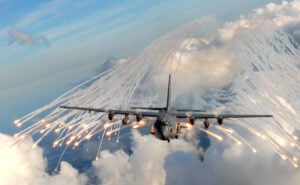WASHINGTON: Sometimes smart bombs aren’t the smart choice. Sometimes you just need a big bad flying gun. That’s why the aging AC-130 gunship is still revered by ground troops for its ability to fire a 105mm cannon — a weapon normally mounted on light tanks. That’s why the head of Air Force Special Operations Command, Lt. Gen. Bradley Heithold, decided the new model, the AC-130J Ghostrider, had to have the 105 instead of relying on missiles. And that’s why Heithold will fight to slow the rate at which older AC-130s are retiring.
“I know we can buy back the two we [were] going to retire… in ’16,” Heithold told me and another reporter after his remarks today to the National Defense Industrial Association. He might even be able to get back the three aircraft that are to be retired in 2015, he said, if only as non-operational Backup Aircraft Inventory (BAI). Even that status would require maintenance that’s not funded in the ’15 budget, however: “I’d…probably have to talk with Congress” to see what’s possible, he said.

An AC-130U’s 105 mm cannon
“I’m not going to be able to maintain 37 [AC-130s in service],” Heithold said, “[but] I’m going to freeze the stick” at 26: 14 AC-130Us and 12 AC-130Ws. (The remaining Vietnam-era AC-130H Spectres will go away).
The U model, aka “Spooky,” is the classic gunship configuration with multiple cannon, including the 105 mm. The W model, aka “Stinger II,” was a special innovation for Afghanistan that had smart weapons — Griffin Missiles and Small Diameter Bombs — but no gun heavier than 30mm. The J-model Ghostrider was originally supposed to enter service looking a lot like the Stinger, with a 30mm gun, Griffins, and SDBs, but with enough spare power and room to maybe mount the 105 mm at some later point. Heithold decided Ghostrider “maybe later” wasn’t good enough.
The venerable 105 gun is in some ways more precise than smart weapons, Heithold said, because its shells contain much less explosive than even the Small Diameter Bomb. Because those shells are smaller than missiles or bombs, an airplane can also carry a lot more of them. And they’re a lot less expensive than smart weapons.
“An AC-130 is a precision strike platform in itself. It precisely delivers very low yield munitions with a 30 [mm gun] and a 105… and they’re very inexpensive to deliver,” Heithold said: about $400 for a 105 mm shell versus $125,000 for a relatively low-cost missile.
So Heithold decided the Ghostrider had to have the big gun from the get-go — even if that risked delaying its entry into service.
“I wouldn’t call it a delay, [but] we probably built a little too much risk into the schedule and what I’m doing is buying down the risk,” Heithold said. The original schedule for retiring AC-130Us and Ws assumed that withdrawal from Afghanistan would lead to lower demand for the gunships, but with increasing terrorist threats, that hasn’t happened. “If peace doesn’t break out, the demand signal is still there,” said Heithold, so he’s going to slow the rate of retirements to get “time to field the J-model correctly.”
“To keep the legacy aircraft is not an exceeding lot of money,” he said, though he did not give a specific figure. “There’s a few [avionics] I have to replace; if we keep flying them I’ve got to put [new] outer wings on ’em. But it’s not a significant amount of money.”
As for the J-model, the first two aircraft will not have the 105mm gun installed. That’ll have to be retrofitted later. “About the third plane, we cut in the 105,” Heithold said. “Technology-wise, this is not a tough thing to do.” AFSOC will simply pull the cannon off retiring aircraft and install them on the Js. (The last seven J-models may carry a laser weapon, he said).

AC-130U firing flares designed to divert heat-seeking missiles
The big gun isn’t the only upgrade the Ghostriders will need, however. They currently lack the full suite of defenses found on the older aircraft. They have chaff, flares, and lasers to blind heat-seeking missiles, the Large Aircraft Infra-Red Counter Measures (LAIRCM) system. What they don’t have is countermeasures against radar-guided missiles. The Air Force can’t simply pull the needed systems off retiring aircraft, either, because they’re hardwired in. AFSOC just put out a Request For Proposals for radio-frequency countermeasures for the J-model, Heithold said: “We’re not going to bring ’em into service until we get ’em there.”
Overall, Heithold envisions a “spiral development” with three phases, although the third may never be built. The two test aircraft flying now are “Block 10” Js with seven crew and no 105 cannon. What’s required for Initial Operating Capability (IOC) will be the Block 20, with the 105 and two more crew, a sensor operator and the cannon gunner. The ultimate Ghostrider? The Block 40, of which anywhere from zero to seven would be built, would carry a directed energy weapon.
“I’ve looked at a lot of capabilities out there in high-energy lasers and microwave energy guns and all those sorts of things. We plan to put some seed money [in],” he told the NDIA conference. “The technology is getting to the point where I think it’s mature enough.”
In a ‘world first,’ DARPA project demonstrates AI dogfighting in real jet
“The potential for machine learning in aviation, whether military or civil, is enormous,” said Air Force Col. James Valpiani. “And these fundamental questions of how do we do it, how do we do it safely, how do we train them, are the questions that we are trying to get after.”


























